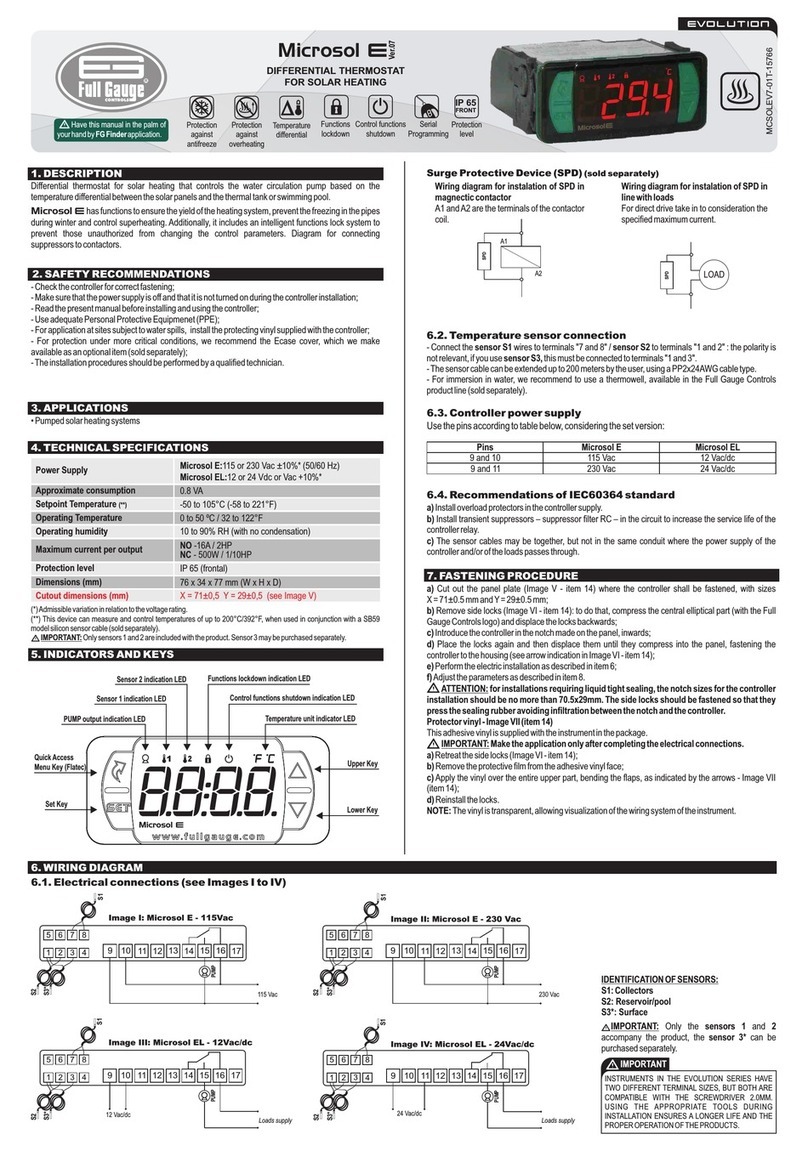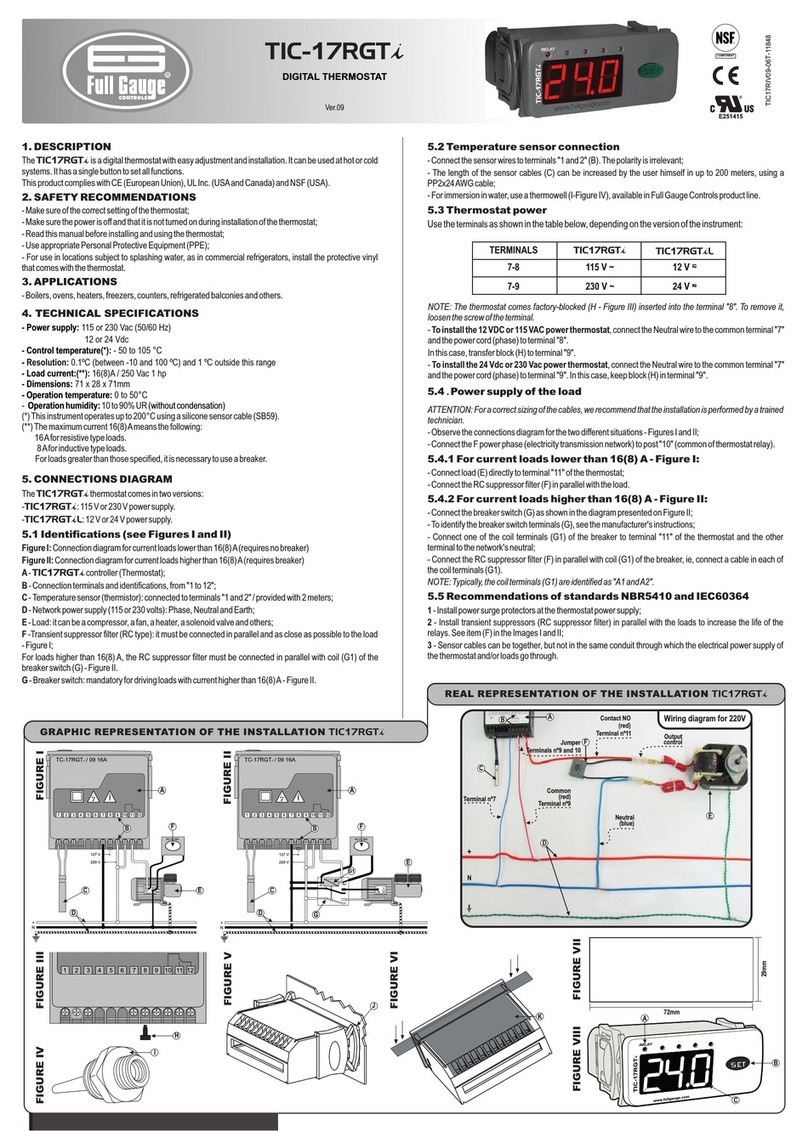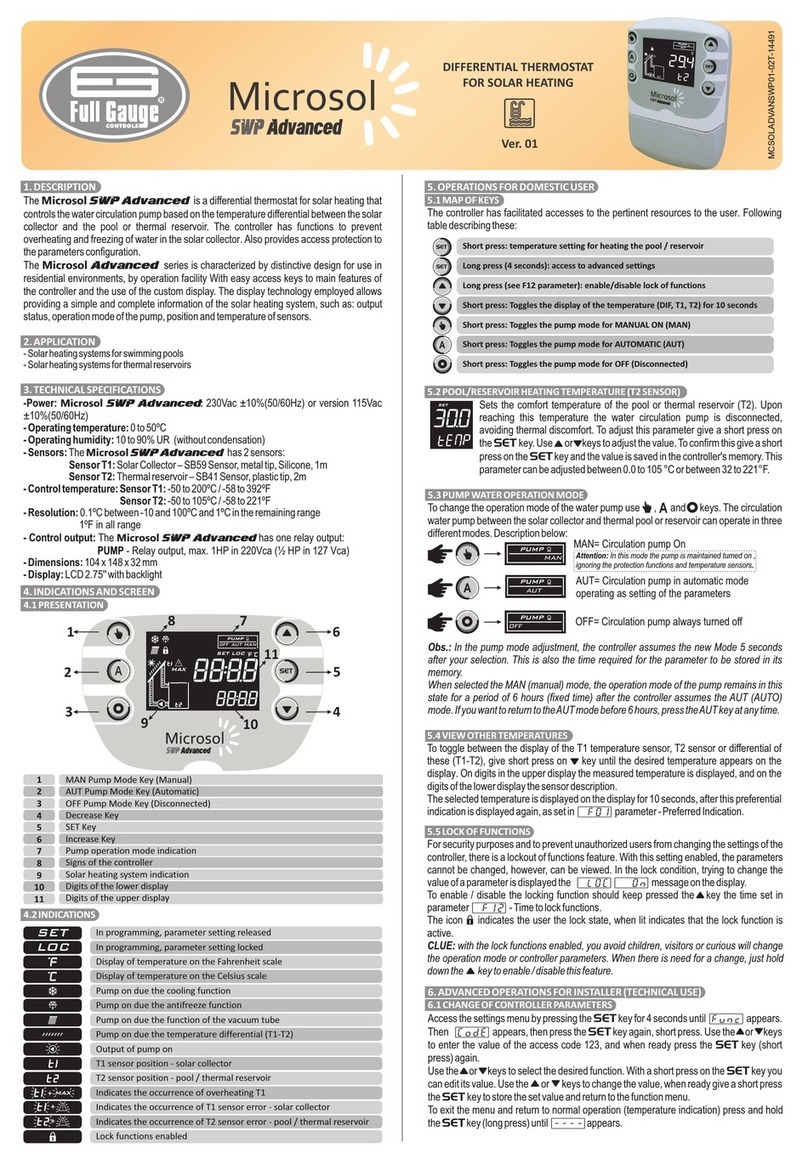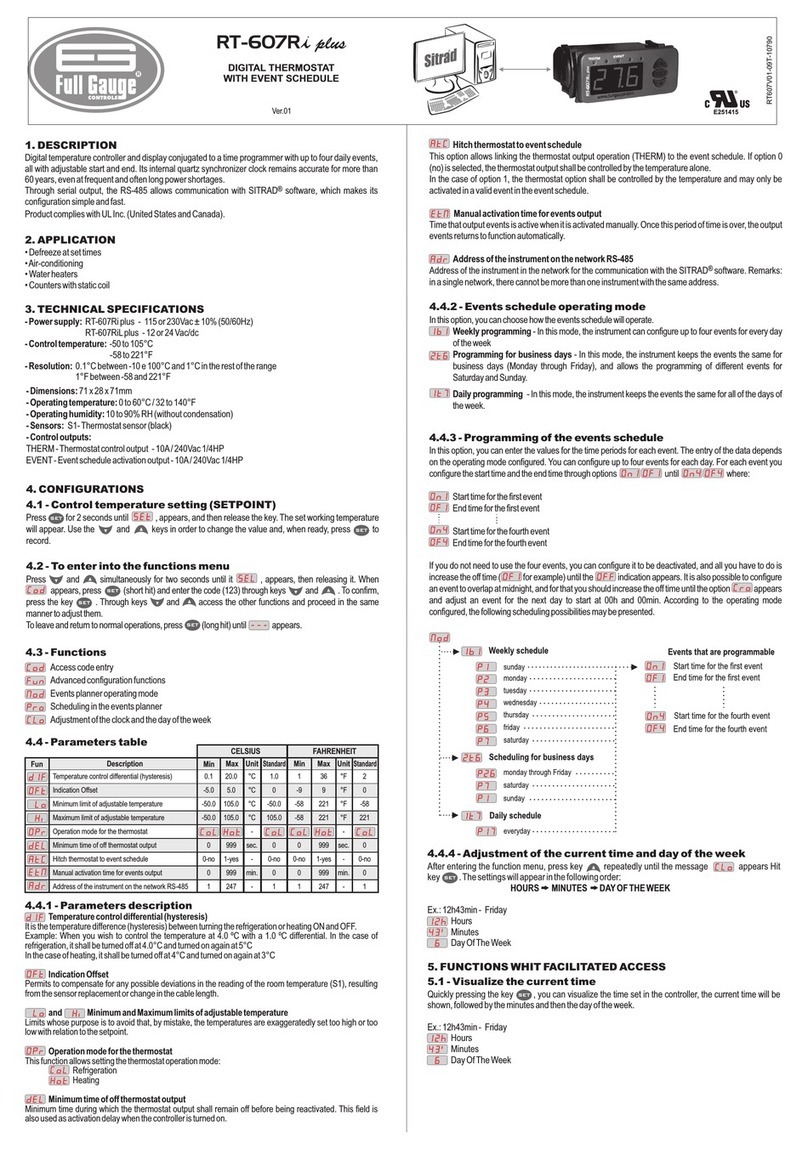8.3.8. Event schedule programming
This option allows entering the values of the time intervals for each event. Data input depends on the
configured operation mode. Up to eight events may be configured for each day. The start time and end
time of each event is set using options[,OnI]to [,On8][Off8], where:
[,On1] - Start time of the 1st event.
[OFF1] - End time of the 1st event.
.
.
.
[,On8] - Start time of the 8th event.
[OFF8] - End time of the 8th event.
NOTE: To program the event schedule outside the facilitated menu, it is necessary to enter the access
code 123. From the menu, press the key ; (quick touck) until you teach the [Prog] menu, skip steps a
and b and then press / (quick touch).
a)Press<and>(quick touch) simultaneously, the option[Code], will be displayed to request the
access code.
b)Press/and enter the access code 123 using the <or>key,confirming with/.The
option[Code]will appear again.
c)Browse the menu using the<or>key until the option[Prog]appears, and then press /. The
following programming options may be displayed depending on the operation mode:
[IbI,]- Weekly Programming
[mode]
[,,p1]- Sunday
[,,p2]- Monday
[,,p3]- Tuesday
[,,p4]- Wednesday
[,,p5]- Thursday
[,,p6]- Friday
[,,p7]- Saturday
[2t6,]- Weekdays Programming
[,p26]- Monday to Friday
[,,p7]- Saturday
[,,p1]- Sunday
[It7,]- Daily Programming
[,p17]- Every day
Events programmable by day
[,0n1]- Start time of the
1st event
[0ff1]- End time of the
1st event
[,0n8]- Start time of the
8th event
[0ff8]- End time of the
8th event
.
.
.
If it is not necessary to use all the eight events then they may be configured in the disabled mode by
increasing the switch off time ([Off1] for instance) until [Off,]is displayed. It is also possible to
configure an event to cross midnight by incrementing the switch off time until the option [Cro,] is
displayed and adjusting an event for the following day starting at 12:00 AM.
d)The time configured for the chosen event will be displayed. Use the<or>key to change the time
and press / again to return to the event programming menu.
e)To leave the event programming menu and return to the home screen, press/until the message
[----]is displayed.
Temperature control differential (hysteresis)
Sensor indication offset
Minimum setpoint allowed to the end user
Maximum setpoint allowed to the end user
Operation mode
Minimum thermostat output off time
Link the thermostat to the event schedule
Event schedule link mode
Time for manual activation of the event output
Preferred measurement view
Recirculation - Scan time
Interval between scans
Maximum time the thermostat output remains on
without reaching the setpoint
Thermostat output off time in state of alarm for not
reaching the setpoint
Digital input operation mode
Digital filter intensity applied to the sensor
Function lock mode
Time for functions lock
Control functions shutdown
Address of the instrument in the RS-485 network
[,f01]
[,f02]
[,f03]
[,f04]
[,f05]
[,f06]
[,f07]
[,f08]
[,f09]
[,f10]
[,f11]
[,f12]
[,f13]
[,f14]
[,f15]
[,f16]
[,f17]
[,f18]
[,f19]
[,f20]
Description
Fun Min Max Unit
CELSIUS FAHRENHEIT
Min Max Unit
StandardStandard
0.1
-5.1(off)
-50
-50
0(cool.)
0(no)
no
0
0(no)
temp.
0(no)
0(no)
0(no)
1
0(off)
0(no)
0
15
0(no)
1
8.5. Parameters table
20.0
5.0
200
200
1(heat.)
999
yes
7
999
all
999
999
999
999
2
9
2
60
4
247
°C
°C
°C
°C
-
sec.
-
-
min.
-
min.
min.
min.
min.
-
-
-
sec.
-
-
1.0
0.0
-50.0
105.0
1(heat.)
0(no)
yes
0
120
temp.
0(no)
0(no)
0(no)
1
0(off)
0(no)
0
15
0(no)
1
°F
°F
°F
°F
-
sec.
-
-
min.
-
min.
min.
min.
min.
-
-
-
sec.
-
-
1
-10(off)
-58
-58
0(cool.)
0(no)
no
0
0(no)
temp.
0(no)
0(no)
0(no)
1
0(off)
0(no)
0
15
0(no)
1
36
9
392
392
1(heat.)
999
yes
7
999
all
999
999
999
999
2
9
2
60
4
247
2
0
-58
221
1(heat.)
0(no)
yes
0
120
temp.
0(no)
0(no)
0(no)
1
0(off)
0(no)
0
15
0(no)
1
F01- Temperature control differential (Hysteresis):
It is the difference in temperature (hysteresis) between TURNING ON and OFF the cooling (or heating).
Example: One wants to control the temperature at 4.0 °C with a differential of 1.0 °C. Therefore, the
cooling is switched off at 4.0 °C and switched back on at 5.0 °C (4.0 + 1.0), in the heating mode the
output is switched off at 4° C and is switched on again at 3° (4.0 - 1.0), as per the charts below:
8.5.1. Description of parameters
Temperature [°C]
Cooling
Setpoint
Setpoint + Hysteresis
Time [S]
Relay Off
Relay On
4°C
5°C
Temperature [°C]
Heating
Setpoint
Setpoint - Hysteresis
Time [S]
3°C
4°C
Relay Off
Relay On
F02 - Sensor indication offset:
It allows compensating possible deviations in the temperature reading caused by the replacement of the
sensor or changes in the cable length. The temperature sensor can be switched off by adjusting this
function to the minimum value until the message[,OFF]is displayed. Under these conditions the
thermostat is disabled and the THERM output changes to the same state as the EVENT output.
F03 - Minimum setpoint allowed to the end user:
Avoids regulation of excessively low setpoint temperatures by mistake.
F04 - Maximum setpoint allowed to the end user:
Avoids regulation of excessively high setpoint temperatures by mistake.
F05 - Operation mode:
Allows selecting the controller operation mode.
[,,,0]- Refrigeration
[,,,1]- Heating
F06 - Minimum thermostat output off time:
It is the minimum time the thermostat output will remain off, i.e. the length of time between the last stop
and the next start up. It is used to relieve the discharge pressure and increase the service life of
compressor. This time is also used as an activation delay when the controller is switched on. This
function can be switched off by setting it at the minimum value 0 [No,,].
F07 - Link the thermostat to the event schedule:
This option allows linking the operation of the thermostat output to the event schedule. If the option 0
(no) is selected, the thermostat output will be controlled by the temperature only. In the case of option 1,
the thermostat output will be controlled by the temperature and will only be activated with a valid event in
the schedule.
F08- Event Schedule link mode:
This function allows the user to define whether the thermostat will work together with the event output or
not. Case the thermostat is linked to the event calendar (F07 = On), this function will inform which events
(times) the THERM and EVENT outputs will work. Otherwise, only EVENT events will be selected.
[,,,0] THERM linked to events 1,2,3,4,5,6,7 and 8.
EVENT linked to events 1,2,3,4,5,6,7 and 8.
[,,,1] THERM linked to event 1.
EVENT linked to events 2,3,4,5,6,7 and 8.
[,,,2] THERM linked to events 1,2.
EVENT linked to events 3,4,5,6,7e 8.
[,,,3] THERM linked to events 1,2,3.
EVENT linked to events 4,5,6,7e and 8.
[,,,4] THERM linked to events 1,2,3,4.
EVENT linked to events 5,6,7e 8.
[,,,5] THERM linked to events 1,2,3,4,5.
EVENT linked to events 6,7 and 8.
[,,,6] THERM linked to events 1,2,3,4,5,6.
EVENT linked to events 7 and 8.
[,,,7] THERM linked to events 1,2,3,4,5,6,7.
EVENT linked to event 8.
NOTE: By default, the event schedule leaves the factory with the same events for every day of the week,
and the schedules defined as fallows:
[,On1] - Opening time of 1st event: 04:00
[Off1] - End time of 1st event: 08:00
[,On2] - Start time of the 2nd event: 17:00
[Off2] - End time of the 2nd event: 21:00
Other events are disabled.
NOTE 2: When the event schedule operation mode is changed all events return to the default.
8.3.9. Unit Selection
To select the units that the system will use to operate, press<and>simultaneously as the
temperature is being displayed, enter the option[Code] using the access code [,231]and then
press/. Then select the desired unit[,=C,]or[,=F,]using the<>keys, and press/to
confirm.
NOTE: Whenever the units are changed, the functions’ configuration assumes the factory default, so
they need to be configured again.
8.4. Advanced operations
8.4.1. Adjustment of the parameters
Parameter adjustment can be done through the quick access menu (;) by accessing the option
[Func], or by pressing <and>simultaneously when the temperature/time is being displayed.
The following options will be displayed:
[Code]Entry to the access code
[Func]Change the advanced parameters
[Mode]Event schedule operation mode
[ProG]Event schedule programming
[ClO,]Adjustment or visualization of the date and time
8.4.2. Access code
To change the parameters or adjust the clock, select the[Code]option by pressing / (quick touch)
and entering the access code 123 (one hundred and twenty-three) using the<or>key, and confirm
with/.
Select the desired function using the<and>keys. Press/ (quick touch) after selecting the function
to view its value. Use<or>to change the value and press/when ready to save the configured
value and return to the functions menu. To leave the menu and return to the normal operating mode
(temperature indication), hold down/ (long touch) until[----]appears.
Note: If the function lock is active, the controller will show the message [LOC,]in the display upon
pressing <or> and will not allow the adjustment of the parameters.
8.4.3. Event schedule operation mode
In the main menu (after entering the code 123) select the option [Mode] and then the desired function
using the<or>keys. The factory default for the controller is [It7,]- Daily Programming.
To leave the menu and return to the normal operating mode (temperature indication), hold
down/(long touch) until [----]appears.
[IbI,]- Weekly Programming: In this mode the instrument can configure up to 8 events for each day
of the week.
[2t6,]- Weekdays Programming: In this mode, the instrument keeps the same events from
weekdays (Monday to Friday) and allows you to program different events for Saturday and Sunday.
[It7,]- Daily Programming: In this mode, the instrument keeps the same events for all days of the
week.





























